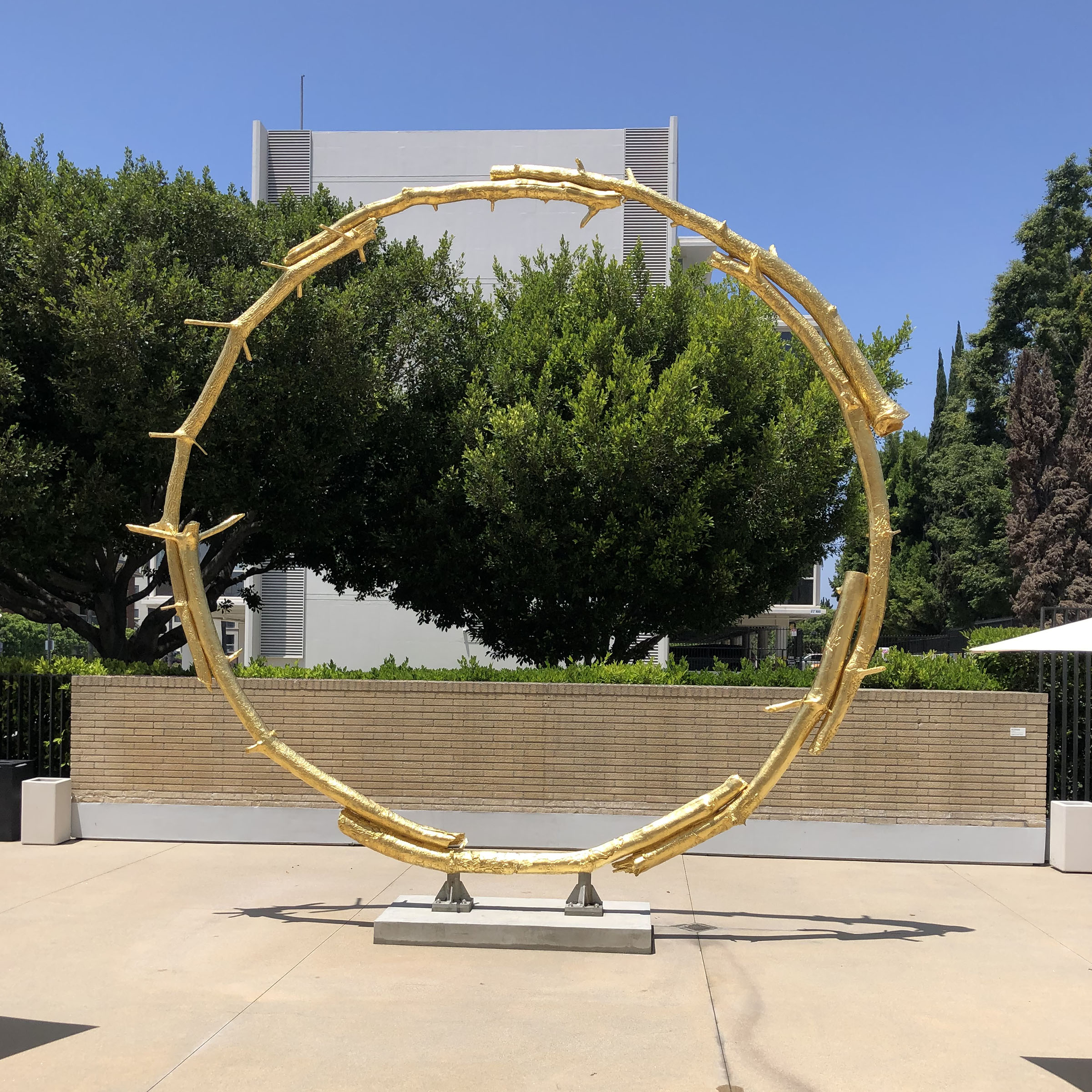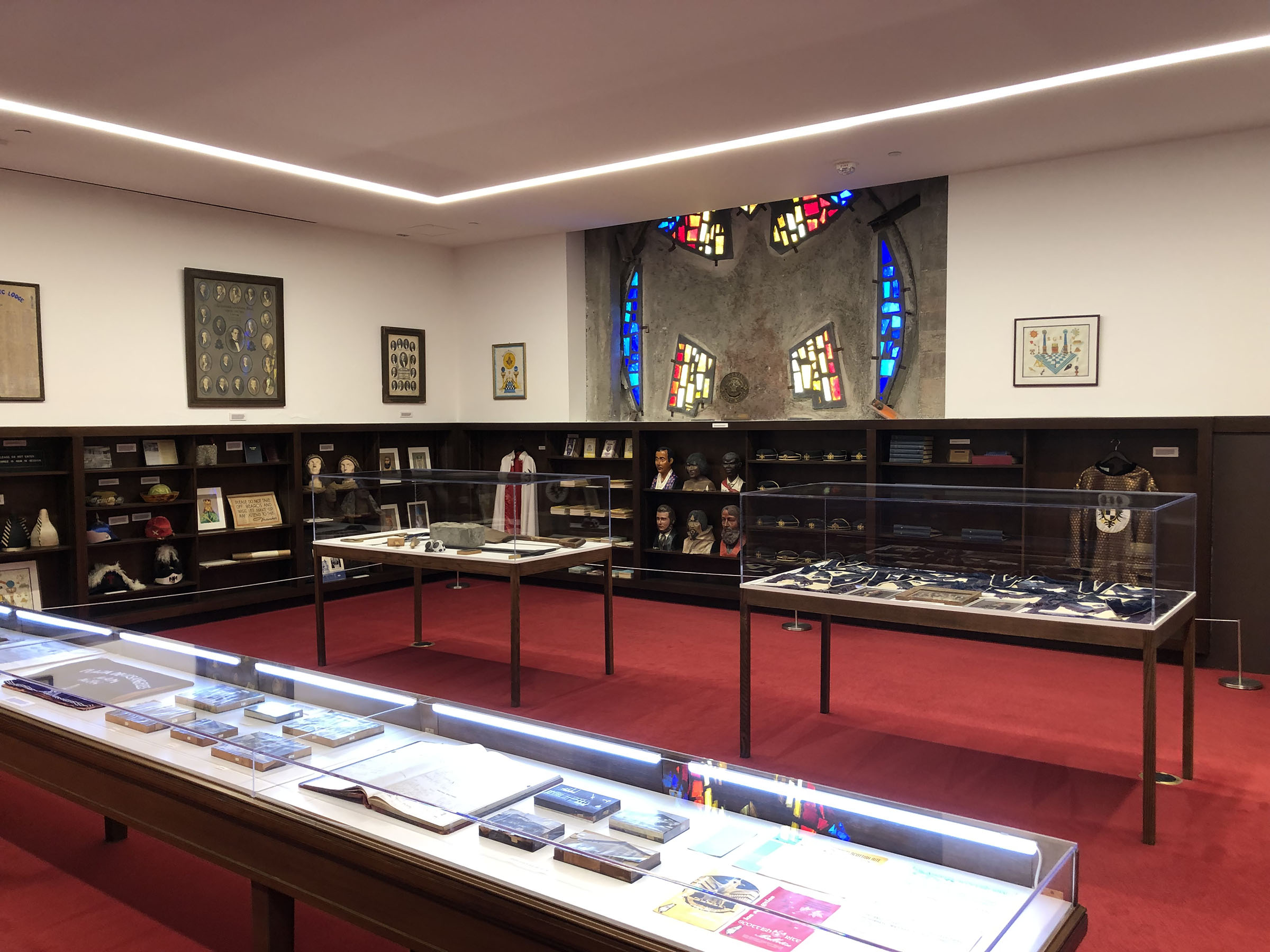 |
| Jeff Koons, Hulk (Dragon and Turtle), 2004-2021. Marciano Art Foundation |
The Marciano Art Foundation is back, in a low-key way. Readers will recall that the private museum of GUESS jeans tycoons Maurice and Paul Marciano opened to great fanfare in 2017, only to close 2-1/2 years later, after workers began a union drive. The employees wanted a raise to their minimum wage of $14.25 an hour. The MAF's closure was described as permanent, and 60-some workers were abruptly dismissed.
Gagosian (which sold the Marciano brothers much of their collection) took over the building from 2021-23, and several cultural organizations used it for performances. In or about Feb. 2024, without much notice at all, the Marciano Art Foundation resumed programming. Independent curator Hanneke Skerath was named director in July 2024. There was an art-star-studded gala for a Doug Aitken installation in Dec. 2024, and that got a little online media. But notwithstanding its Wilshire address, the new MAF is flying under the radar. As far as I can tell, neither the Los Angeles Times nor the New York Times has covered the reopening.
 |
| Marciano Art Foundation (former Scottish Rite Masonic Temple). Photo by Yohsihiro Makino |
The new MAF is pretty much the old MAF, minus the big loan shows. It retains the fascinatingly bizarre building—a windowless Masonic Temple designed by midcentury painter and muralist Millard Sheets—and the Marcianos' ~1500-piece collection. As before, they've got a small sculpture plaza; a cavernous, 13,000-sf Theater Gallery on the ground floor; murals by Alex Israel and Nicolas Party; a room of Masonic regalia; a suite of third-floor galleries showing thematic rotations from the Marciano collection.
 |
| Ugo Rondinone, the sun, 2017 |
 |
| Alex Israel, Valet Parking (mural), 2013 |
 |
| "Relic Room" of Masonic objects |
 |
| Installation view of "Transmissions" with Sherrie Levine's Dada, 2008, in foreground |
 |
"Transmissions" on third-floor Ballroom Gallery
|
 |
| "Barbara T. Smith: Xerox 914" in MAF library. Industrial foam seating is Quaternion by Kristen Wentrcek and Andrew Zebulon |
The former cafe and bookstore are gone. The latter is now a library that shows small installations (currently, "Barbara T. Smith: Xerox 914," through July 5, 2025; and hand-carved foam furniture by Kristen Wentrcek and Andrew Zebulon). The library also has a Millard Sheets mural. Sheets' third-floor mosaic mural, which was hard to view properly in the old incarnation, is now off view. The second-floor galleries are closed.
 |
| Amy Sillman, Machine, 2024 |
The main attraction is "Transmissions: Selections from the Marciano Collection," curated by director Hanneke Skerath and her collaborator Douglas Fogle. It's over a hundred works by 58 artists on the loose theme of "generat[ing] signals into the ether for us to hear." Most relevant is The Great Silence, an amusing sci-fi film by Jennifer Allora and Guillermo Calzadilla. Otherwise, it's an all but random selection of art by the likes of Tauba Auerbach, Louise Bourgeois, Mark Bradford, Thomas Demand, David Hammons, Mike Kelley, Jeff Koons, Barbara Kruger, Yayoi Kusama, Liz Larner, Louise Lawler, Deana Lawson, Sherrie Levine, Glenn Ligon, Catherine Opie, Raymond Pettibon, Rosemarie Trockel, and Kaari Upson. Five Upson works form a meditative chapel within a large gallery, and there are 40 of Opie's platinum print Freeways.
A few loans include a big Silke Otto-Knapp mural from the Hammer and ceramics by Magdalena Suarez Frimkess from a private collection. "Transmissions" has been running since Feb. 2024, and the MAF site doesn't give an end date.
The old MAF was the city's most contemporary museum-like space. Nearly everything on view was made in the past decade or so. In contrast "Transmissions" feels a beat removed from the current moment. There are only a few pieces dating from after the 2019 closure, pandemic, and Trump restoration. (One is a numinous 2024 abstraction by Amy Sillman.)
This is the eternal issue with vanity museums of contemporary art. The art of right now will inevitably become a period piece. Is there/will there be an audience for a museum of art of the 2000s and 2010s specifically? What's the plan going forward?
 |
| MAF parking lot from third-floor balcony |
The new MAF has an awareness problem. On my visit (a Friday around noon), the parking lot was almost empty. Inside, there were more guards/docents than visitors. Ironically, the MAF claimed low attendance as the reason for the 2019 closure. I don't know how much they're paying the staff, but the new operation must have vastly higher labor costs than the old, per visitor.
The MAF is open Tuesday through Saturday, 11 to 6. Admission (and parking) are free, but timed reservations are required.
 |
| David Hammons, untitled, 2007 |
 |
| Rosemarie Trockel, Scène primitive 1, 2006 |
 |
| Mark Leckey, Inflatable Felix, 2014 |
 |
| From a 2017 post: A Venn diagram of the Marciano and Broad collections' artists |














Comments
> attendance as the reason for the
> 2019 closure.
Since the Hammer, MOCA and Norton Simon each year don't exactly attract SRO crowds either, the Marciano in the next several years (assuming its owner remains committed) will really have a lot of visitors dressed up as empty galleries.
Even the Getty, Huntington and LACMA take a back seat to the number of people each year flowing through Southern California's theme or amusement parks.
I recall an article years ago published in something like the San Francisco Chronicle haughtily claiming that people in LA weren't as much into visual arts (based on museums' attendance figures) as people in Northern California were (ouch). It was similar to reading an online review (around 15 years ago?) of LACMA from a tourist based in Minnesota who compared it unfavorably with the Minneapolis Institute of Art (ouch).
Not just the Marciano is under the radar, but the jewel-like Norton Simon (whose PR isn't tarnished due the controversy of owner-employee relations) - and things like its 50th anniversary and upcoming renovation - doesn't get too much more attention either.
heysocal. com: "As the [Norton Simon] museum celebrates its 50th anniversary, it is undergoing an exterior improvement project to make it more inviting for these television viewers and people on the grandstands to come in and discover the treasures found within
.
The museum...welcomes 150,000 visitors per year, 70% of whom are local and 30% from Southern California, other states and abroad."
^ 150,000? Again, that's not exactly SRO.
The museums of Paris look at Los Angeles and sniff, "Hold my beer."
"(ouch)"?
If you set Paris as the bar for LA's fine-arts local culture, you do not know Paris either.
However, from a cosmetic standpoint, MIA looks the part---early 1900s Beaux-Arts. Periera's/Hardy-Pfiffier's 1965-1986 campus did not. So in one way, the online review of LACMA was correct.
In regards to international attendance figures of art museums (at the time, if not still today), the article from San Francisco - estimate it was written around 15 years ago - was correct too.
As for Paris, "you do not know" needs details or clarification. However, in terms of annual visitor count, it's to museums of the world what Orlando is to amusement parks of the world.
However, I've seen figures way more recently and I recall thinking how even the Getty (Center and Villa combined---both free to enter too) didn't have as large an annual attendance as I had assumed.
BTW, my first comment focused on "...claimed low attendance as the reason for the 2019 closure..."
If directors, curators and staff of most museums - of art, history etc - are like people in general, they'll feel better if they're more popular instead of not popular.
He's a de facto stupid person, but not a very good one.
I approach a Met or MIA as fieldwork projects on a greater understanding of art history. Every collection, I find, has works that are puzzle pieces on the art historical spectrum. At MIA, for example, some of their pictures are the best of the best in this country. I believe the same of LACMA, too. And so with scores of other US museums that orange avatar degrades, in favor of his "better" places.
Sad that he's so proudly clueless.
> is a degrader.
Is that the best you can do too?
BTW, if you make a stink about my comments, I'll make a stink about yours. Such as your often bringing up something about what's in a collection of an art museum on the East Coast.
Isn't there a METonfire blog?
Actually, blogs like this don't receive enough feedback as it is, so even posts from someone as jerkass as "he's a de factor stupid person" are better than nothing. Meanwhile, entries on an X/Twitter, Instagram or Youtube, etc, may generate thousands of comments.